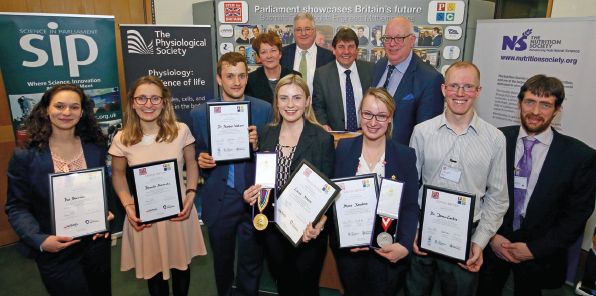
Physiology News Magazine
Sitting is the new smoking: research of The Physiological Society Gold Prize for Biological and Biomedical Sciences winner
News and Views
Sitting is the new smoking: research of The Physiological Society Gold Prize for Biological and Biomedical Sciences winner
News and Views
Maria Karabova, Kings College London, London, UK
https://doi.org/10.36866/pn.111.15

Ten years ago, I walked by St. Thomas Abbey every Monday morning on my way to biology lectures, feeling privileged to study in the town where Gregor Mendel built the foundations of modern biology. This made winning The Physiological Society Gold Prize for Biological and Biomedical Sciences, at STEM for Britain 2018, especially meaningful for me.
STEM for Britain 2018 is an event founded by the late Eric Wharton, fostering greater dialogue and engagement between early career researchers and parliamentarians, held annually at the Houses of Parliament.
The findings I presented demonstrate the powerful impact of regular early-life exercise on brain health as we age. These results are particularly important in light of the expansion of the elderly population. While medical advancements enable us to live longer, this increase in life expectancy sadly seems to go hand in hand with the rising prevalence of incurable age-related brain diseases.
One such disease is Alzheimer’s disease (AD) – a neurodegenerative disorder that manifests on a molecular level as an accumulation of amyloid-beta plaques and neurofibrillary tangles in the brain. Clinical symptoms include a progressive deterioration of memory and other cognitive capacities, ultimately robbing people of their memories, daily independence and dignity. While we are still searching for an effective cure, it makes sense to focus on prevention, mitigating the risk factors that play a role in AD development.
A recent review of the influences contributing to the onset of memory loss and Alzheimer’s disease revealed that ‘sitting is the new smoking’; in other words, a sedentary lifestyle represents the third greatest risk factor worldwide. For centuries, we have intuitively known that physical activity is beneficial for our wellbeing. Hippocrates said, ‘If we could give every individual the right amount of nourishment and exercise we would have found the safest way to health.’
Surprisingly, the effect of regular physical activity early in life, such as in childhood, on longitudinal maintenance of brain health has previously never been explored – even though the evidence suggests that boosting physical activity could potentially represent a new frontier for preventing memory loss and AD symptoms in the elderly.
In the second year of my undergraduate studies, I had the opportunity to spend a year abroad at the University of California in Irvine. This is where I came across Carl W Cotman, a world-leading expert on exercise and brain health. I decided to interrupt my studies and undergo a year-long work placement under his supervision. He kindly trusted me to join his project aiming to systematically map the effect of early-life exercise on brain ageing.
As such a study is difficult to conduct in humans, we turned to mice. We provided young mice (2 months old) with access to running wheels for two days, two weeks or four weeks and tested their spatial memory with behavioral tests in adulthood (6 months and 9 months) as well as in old age (18 months). The results were nothing short of remarkable.
In adulthood and old age, activity and mobility was significantly improved in mice that exercised for two or four weeks in young age compared with those that only exercised for two days or remained sedentary.
In addition, mice that were regularly active for two or four weeks in young age performed significantly better in memory tests in adulthood as well as in old age. We hypothesised that regular early-life exercise creates a type of cognitive reserve, which protects the ageing brain and renders it resilient to cognitive decline. While the molecular changes underlying this protective effect are not clear, our results indicated that an increase in structural synaptic plasticity as well as brain-derived neurotrophic factor availability may be a good starting point to look at.
I hope that the work I presented will contribute to STEM for Britain’s goal of building a bridge between the scientific community and the parliamentarian, and that our results will serve as a catalyst for implementing more youth movement programmes to battle the alarming rise in age-related memory loss and Alzheimer’s disease.
